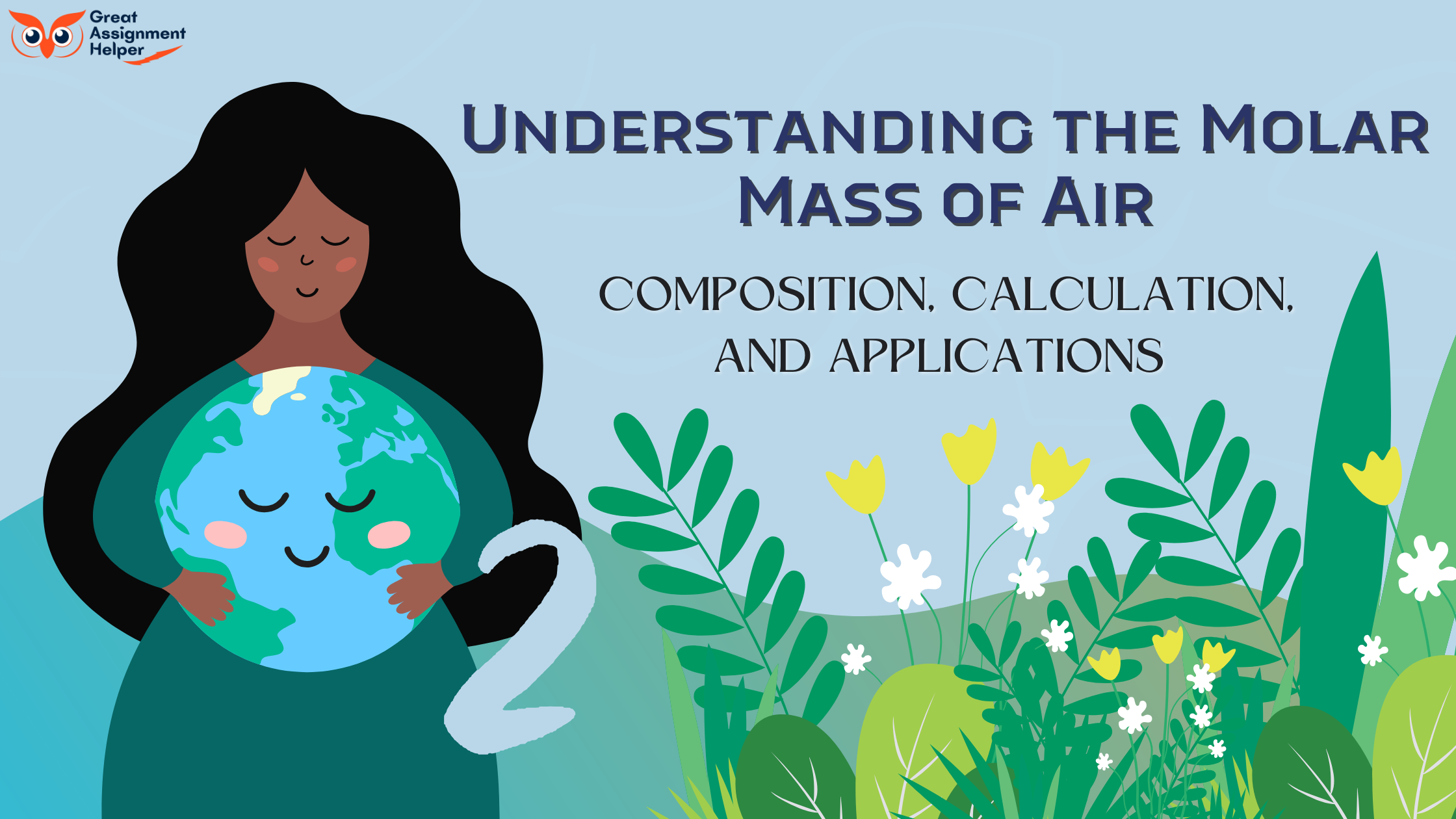
Air, the invisible yet vital mixture enveloping our planet, plays a crucial role in sustaining life and influencing various scientific and industrial processes. One fundamental property of air that is pivotal in fields ranging from meteorology to engineering is its molar mass.
This article delves deep into the concept of the molar mass of air, exploring its significance, calculation methods, and applications.
Listen To This Blog
What is Molar Mass?
Molar mass, often denoted as M, is the mass of one mole of a substance, typically expressed in grams per mole (g/mol). It serves as a bridge between the microscopic world of atoms and molecules and the macroscopic world we observe, allowing scientists to relate the amount of substance to its mass.
Composition of Air
Air is a homogeneous mixture of various gases. The primary constituents of dry air and their approximate volume percentages are:
- Nitrogen (N₂): 78.08%
- Oxygen (O₂): 20.95%
- Argon (Ar): 0.93%
- Carbon Dioxide (CO₂): 0.04%
- Other gases (Neon, Helium, Methane, etc.): Trace amounts.
These proportions can vary slightly depending on environmental factors and location.
Calculating the Molar Mass of Air
To determine the molar mass of air, we consider it as a mixture of its constituent gases. The molar mass of a mixture can be calculated using the formula:
M = Σ (xᵢ × Mᵢ) Where:
- xᵢ is the mole fraction of component i
- Mᵢ is the molar mass of component i
Applying this to dry air:
- Nitrogen: 78.08% × 28.0134 g/mol = 21.87 g/mol
- Oxygen: 20.95% × 31.9988 g/mol = 6.70 g/mol
- Argon: 0.93% × 39.948 g/mol = 0.37 g/mol
- Carbon Dioxide: 0.04% × 44.0095 g/mol = 0.02 g/mol
Summing these values:
Molar Mass of Air ≈ 28.96 g/mol
This value aligns with standard references, which state the molar mass of dry air as approximately 28.9647 g/mol
Units of Molar Mass
While grams per mole (g/mol) is the standard unit for molar mass, other units are also used, especially in engineering contexts:
- Kilograms per mole (kg/mol): 1 g/mol = 0.001 kg/mol
- Pounds per mole (lb/mol): 1 g/mol ≈ 0.00220462 lb/mol
Therefore, the molar mass of air can also be expressed as:
- 0.02896 kg/mol
- 0.0639 lb/mol
Molar Mass vs. Molecular Weight
The terms "molar mass" and "molecular weight" are often used interchangeably, but they have subtle differences:
- Molar Mass: The mass of one mole of a substance, expressed in g/mol.
- Molecular Weight: A dimensionless quantity representing the ratio of the average mass of molecules of a substance to 1/12 the mass of a carbon-12 atom.
In practice, for gases like air, the numerical values are the same, so the distinction is often overlooked.
Impact of Humidity on Air's Molar Mass
The presence of water vapor (humidity) affects the molar mass of air. Water vapor has a molar mass of approximately 18.015 g/mol, which is less than that of dry air.
As humidity increases, the proportion of lighter water molecules increases, leading to a decrease in the average molar mass of air. This phenomenon explains why humid air is less dense than dry air at the same temperature and pressure.
Applications of Air's Molar Mass
Understanding the molar mass of air is essential in various scientific and engineering applications:
Meteorology:
Calculating atmospheric pressure, density, and predicting weather patterns.
Aviation:
Determining air density for aircraft performance and flight dynamics.
Environmental Science:
Modeling pollutant dispersion and understanding greenhouse gas effects.
Engineering:
Designing HVAC systems and combustion engines.
Chemistry:
Calculating the number of moles in gas reactions using the ideal gas law.
Determining Molar Mass from Density
The molar mass of a gas can be determined using its density through the ideal gas law:
PV = nRT
Where:
- P is pressure
- V is volume
- n is the number of moles
- R is the ideal gas constant
- T is temperature
Rewriting the equation in terms of molar mass (M):
M = (ρRT)/P
Where:
- ρ is the density of the gas
This formula allows for the calculation of molar mass when the density, temperature, and pressure of a gas are known .
Air Density at Room Temperature
At standard room temperature (20°C or 293.15 K) and atmospheric pressure (1 atm or 101.325 kPa), the density of dry air is approximately 1.204 kg/m³. This value is crucial for various calculations in physics and engineering.
Molar Composition of Air
The molar composition of air refers to the mole fractions of its constituent gases. As previously mentioned, the primary components are nitrogen, oxygen, argon, and carbon dioxide. Understanding this composition is essential for accurate calculations involving air's molar mass and related properties.
Mass of Air on Earth
Estimating the total mass of Earth's atmosphere involves integrating the density of air over the entire volume of the atmosphere. The total mass is approximately 5.15 × 10¹⁸ kg. This immense mass plays a vital role in Earth's climate, weather systems, and the sustenance of life.
Conclusion
The molar mass of air is a fundamental property with wide-ranging implications in science and engineering. By understanding its value, composition, and the factors affecting it, we can better comprehend atmospheric phenomena, design efficient systems, and predict environmental changes. Whether you're a student, researcher, or professional, grasping the concept of air's molar mass is essential for accurate analyses and innovations.
Frequently Asked Questions (FAQs)
1. What is the molar mass of air?
The molar mass of air is approximately 28.97 g/mol, which means one mole of air weighs about 28.97 grams under standard conditions. This value is an average based on the composition of gases in the atmosphere, mainly nitrogen, oxygen, argon, and carbon dioxide.
2. What is the molecular weight of air?
The molecular weight of air is synonymous with its molar mass, both referring to approximately 28.97 g/mol. It represents the mass of one mole of air molecules, considering the atmospheric gas mixture.
3. How do you calculate the molar mass of air?
To calculate the molar mass of air, multiply the molar mass of each component gas by its mole fraction and then sum the results: Molar Mass of Air=∑(Xi×Mi)\text{Molar Mass of Air} = \sum (X_i \times M_i)Molar Mass of Air=∑(Xi×Mi) where XiX_iXi is the mole fraction and MiM_iMi is the molar mass of each gas.
4. What is the molar mass of air in kg/mol?
The molar mass of air in kg/mol is 0.02897 kg/mol. Since 1 gram = 0.001 kilograms, simply divide the g/mol value by 1,000.
5. What is the molecular weight of dry air?
The molecular weight of dry air is also 28.97 g/mol, excluding water vapor. Moist air has a slightly lower molecular mass because water vapor (H₂O) has a molar mass of about 18 g/mol, which dilutes heavier gases.
6. How to calculate molar mass from density?
You can calculate molar mass from density using the Ideal Gas Law: M=dRTPM = \frac{dRT}{P}M=PdRT Where: MMM = molar mass ddd = density (kg/m³) RRR = gas constant (8.314 J/mol·K) TTT = temperature in Kelvin PPP = pressure in Pascals
7. What is the air molecule mass?
The mass of an individual air molecule depends on the composition but typically averages around 4.8 × 10⁻²⁶ kg per molecule. This is derived by dividing the molar mass by Avogadro’s number.
8. What is the atomic mass of air?
Air is a mixture and does not have a single atomic mass. However, you can approximate its atomic mass based on the average molar masses of its constituent elements, primarily nitrogen and oxygen.
9. How many moles are in the air?
At standard temperature and pressure (STP), 1 mole of air occupies 22.4 liters. If you know the volume of air, you can calculate moles using: Moles=Volume of air (L)22.4\text{Moles} = \frac{\text{Volume of air (L)}}{22.4}Moles=22.4Volume of air (L)
10. What is the average molecular weight of air on Earth?
The average molecular weight of air on Earth is 28.97 g/mol. This includes nitrogen (~78%), oxygen (~21%), argon (~0.93%), and carbon dioxide (~0.04%), which make up the majority of the molar composition of air.

